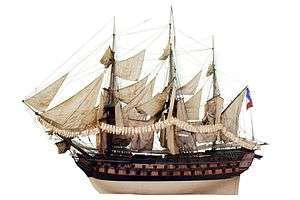HMS Spartiate (1798)
 Scale model of Achille, sister ship of HMS Spartiate (1798), on display at the Musée de la Marine in Paris. | |
| History | |
|---|---|
| Name: | Spartiate |
| Builder: | Toulon shipyard |
| Laid down: | November 1794 |
| Launched: | 24 November 1797 |
| Commissioned: | March 1798 |
| Honours and awards: |
|
| Captured: | 2 August 1798, by Royal Navy |
| Name: | HMS Spartiate |
| Acquired: | 2 August 1798 |
| Out of service: | August 1842 |
| Honours and awards: |
|
| Fate: | Broken up, May 1857 |
| General characteristics | |
| Class and type: | Téméraire-class ship of the line |
| Displacement: |
|
| Length: | 55.87 metres (183.3 ft) (172 pied) |
| Beam: | 14.90 metres (48 ft 11 in) |
| Draught: | 7.26 metres (23.8 ft) (22 pied) |
| Propulsion: | Up to 2,485 m2 (26,750 sq ft) of sails |
| Armament: |
|
| Armour: | Timber |
The Spartiate was originally a French 74-gun ship of the line, launched in 1797. In 1798, she took part in the Battle of the Nile, where she became one of the nine ships captured by the Royal Navy.
In 1805, HMS Spartiate fought at the Battle of Trafalgar under Francis Laforey. With Minotaur, she forced the surrender of the Spanish ship Neptuno, of 80 guns. Casualties were three killed (two seamen & one boy), and twenty wounded (the boatswain [Clarke], two Midshipmen [Bellairs & Knapman], one Marine [William Parsons] and sixteen sailors), according to the three logs (Captain's log, Ship's log, Master's log).
Spartiate returned to her home port of Plymouth for repairs from December 1805 to February 1806. Thereafter she joined the Channel Fleet and, for the next two years, was involved in the blockade of Rochefort.[note 1] In January 1808, she was in Admiral Strachan's squadron, and pursued Contre-Admiral Zacharie Allemand's flight from Rochefort. On 21 February 1808 she joined the Mediterranean Fleet at Palermo, and was deployed here until the end of 1809. In June 1809, she participated in the attack on the islands of Ischia and Procida.
On board during the Trafalgar action was First-Lieutenant James Clephan, who was presented with the ship's Union Jack by the crew after the battle as a mark of their esteem.[1] The flag, recently found in a drawer of one of the descendants of James Clephan, is regarded as the only surviving Union Jack from the Battle of Trafalgar. With battle scars still visible, it was sold for £384,000 when it went for auction in London during October 2009.[2]
Spartiate was converted to a sheer hulk in August 1842. She was later broken up, a process completed on 30 May 1857.
Notes
- ↑ The Captain's log does show that she returned to the United Kingdom for replenishment purposes at the following time periods: 25 July to 3 August 1806, 14 January to 26 February 1807, 29 June to 16 September 1807
Citations
- ↑ The Times October 8, 2009
- ↑ "Trafalgar union jack up for sale". BBC News. 8 October 2009. Retrieved 6 February 2015.
References
- Colledge, J. J.; Warlow, Ben (2006) [1969]. Ships of the Royal Navy: The Complete Record of all Fighting Ships of the Royal Navy (Rev. ed.). London: Chatham Publishing. ISBN 978-1-86176-281-8. OCLC 67375475.
- Lavery, Brian (2003) The Ship of the Line - Volume 1: The development of the battlefleet 1650-1850. Conway Maritime Press. ISBN 0-85177-252-8.
- Winfield, Rif (2005) British warships in the age of sail, 1793-1817 : design, construction, careers & fates
- Lyon, David J (2003) The sailing navy list: all the ships of the Royal Navy built, purchased and captured 1688-1860